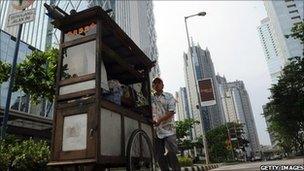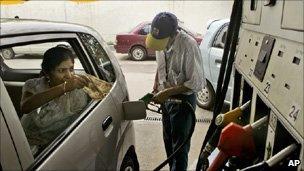Can buoyant Asia withstand a euro shock?
- Published

Indonesia weathered the financial crisis of 2008 relatively well
Picture this.
It's evening rush hour. The streets are packed with brand new motorcycles and cars. Giant billboards advertise the latest designer goods and consumer electronics. Music blares from stores nearby - enticing customers to spend. Many stream in and out of super-sized malls, laden with shopping bags. Conspicuous consumption is very much in fashion.
Now tell me - where are you? Jakarta, the Indonesian capital, or Mumbai, India's busy and bustling commercial city?
You'd be hard pressed to figure out which city this image describes.
Both of these sprawling Asian cities are witnessing an explosion in their middle classes, which has led to a huge consumer boom, powering their domestic economies.
Ask a professional Indonesian or Indian these days whether their economic prospects are better today then ten years ago, and the answer would be a resounding yes.
That's in sharp contrast to what's happening in the Eurozone or the US, where jobs are few and far between, and people are struggling to survive.
The hope is that its consumers in countries like India and Indonesia that will help to lift the mood of the global economy, and drive growth - at a time when things seem so dismal elsewhere.
It certainly seems like a sensible theory - given that Indonesian and Indian consumers are more willing to spend their hard-earned cash on everything and anything these days - from fashion, to food. Car and motorcycle sales have soared recently, as have the sales of other consumer goods like refrigerators, television sets and kitchen appliances. All signs of a booming and growing middle class.
But is it truly realistic that these nations can stave off the effects of another global financial crisis?
"The countries that can balance and drive growth forward, are Indonesia, India and China - they are all prime candidates to do this," said Enrique Blanco Amras with the World Bank in Indonesia.
"Just look at what happened in 2008 - Indonesia was able to come out of that crisis relatively well, growth only declined to 4.6% in 2009. That was a year that a lot of countries were having negative growth. So it stands to reason that Indonesia could weather the storm this time round too."
So it looks like both Indonesia and India could withstand the cold winds of another financial crisis. But not everyone agrees - well, not entirely.
"India understands that in order to insulate its economy from the global financial crisis - it needs to develop its infrastructure, so more jobs can be created," says Debnath Guharoy with the international consultancy Roy Morgan. "In fact India started at a worse stage in terms of infrastructure than Indonesia did over a decade ago - but India is now doing better."
India and Indonesia don't just have their huge domestic markets in common. They also have highways, roads, ports and airports that are in desperate need of makeovers. Both governments have said they are committed to improving the infrastructure in their nations - but sadly, actions have yet to match the rhetoric.

Indian people are having to deal with higher prices of everyday goods like food and fuel
The other commonality between these two nations is their massive populations - and the large number of people who still live below the poverty line.
In Indonesia the government estimates that 13 percent of the population lives under the poverty line - but economists say that number is deceptively low. They say it's conceivable that almost half of Indonesia's 240 million strong population is still struggling to survive.
In India, the figures paint an equally miserable picture, with about a third of the population living under the poverty line.
Both India and Indonesia's governments have made poverty alleviation one of their top priorities. Impressive growth rates have certainly helped this process along - and arguably more people in both of these countries are far better off economically today than ever before.
But this economic stability is a fragile one, and must be closely monitored. Asia is now battling with the higher cost of living - and for many people, food prices are starting to become unaffordable. All of this coming at a time when economies in the West are becoming increasingly unstable. Both India and Indonesia need strong growth rates to ensure their citizens have a shot at a better life. Their governments need to act swiftly to make sure that this moment of panic doesn't get in the way of their economic success.